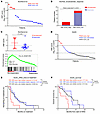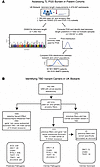Issue published August 15, 2025 Previous issue

- Volume 135, Issue 16
Go to section:
On the cover: SOX2 regulates upper GI squamous epithelial identity
Jin et al. report the critical role of the transcription factor SOX2 in foregut squamous epithelial differentiation. Decreased expression of SOX2 is an initiating step in progression to Barrett’s esophagus. The cover art was produced using Adobe Photoshop based on an H&E image of Barrett’s esophagus adjacent to esophageal squamous epithelium. Image credit: Ramon Jin.
In-Press Preview - More
Abstract
Protein phosphatase 2A (PP2A) is a serine/threonine phosphatase in the brain. Mutations in PPP2R1A, encoding the scaffolding subunit, are linked to intellectual disability, although the underlying mechanisms remain unclear. This study examined mice with heterozygous deletion of Ppp2r1a in forebrain excitatory neurons (NEX-het-conditional knockout, NEX-het-cKO). These mice exhibited impaired spatial learning and memory, resembling Ppp2r1a-associated intellectual disability. Ppp2r1a haploinsufficiency also led to increased excitatory synaptic strength and reduced inhibitory synapse numbers on pyramidal neurons. The increased excitatory synaptic transmission was attributed to increased presynaptic release probability (Pr), likely due to reduced levels of 2-arachidonoyl glycerol (2-AG). This reduction in 2-AG was associated with increased transcription of monoacylglycerol lipase (MAGL), driven by destabilization of enhancer of zeste homolog 2 (EZH2) in NEX-het-cKO mice. Importantly, the MAGL inhibitor JZL184 effectively restored both synaptic and learning deficits. Our findings uncover an unexpected role of PPP2R1A in regulating endocannabinoid signaling, providing fresh molecular and synaptic insights into the mechanisms underlying intellectual disability.
Authors
Yirong Wang, Weicheng Duan, Hua Li, Zhiwei Tang, Ruyi Cai, Shangxuan Cai, Guanghao Deng, Liangpei Chen, Hongyan Luo, Liping Chen, Yulong Li, Jian-Zhi Wang, Bo Xiong, Man Jiang
Abstract
Inflammatory diseases contribute to secondary osteoporosis. Hypertension is a highly prevalent inflammatory condition that is clinically associated with reduced bone mineral density and increased risk for fragility fracture. In this study, we showed that a significant loss in bone mass and strength occurs in two pre-clinical models of hypertension. This accompanied increases in immune cell populations, including monocytes, macrophages, and IL-17A-producing T cell subtypes in the bone marrow of hypertensive mice. Neutralizing IL-17A in angiotensin (ang) II-infused mice blunted hypertension-induced loss of bone mass and strength due to decreased osteoclastogenesis. Likewise, the inhibition of the CSF-1 receptor blunted loss of bone mass and prevented loss of bone strength in hypertensive mice. In an analysis of UK Biobank data, circulating bone remodeling markers exhibited striking associations with blood pressure and bone mineral density in > 27,000 humans. These findings illustrate a potential mechanism by which hypertension activates immune cells in the bone marrow, encouraging osteoclastogenesis and eventual loss in bone mass and strength.
Authors
Elizabeth M. Hennen, Sasidhar Uppuganti, Néstor de la Visitación, Wei Chen, Jaya Krishnan, Lawrence A. Vecchi III, David M. Patrick, Mateusz Siedlinski, Matteo Lemoli, Rachel Delgado, Mark P. de Caestecker, Wenhan Chang, Tomasz J. Guzik, Rachelle W. Johnson, David G. Harrison, Jeffry S. Nyman
Abstract
Cancer cells present neoantigens dominantly through MHC class I (MHCI) to drive tumor rejection through cytotoxic CD8+ T-cells. There is growing recognition that a subset of tumors express MHC class II (MHCII), causing recognition of antigens by TCRs of CD4+ T-cells that contribute to the anti-tumor response. We find that mouse BrafV600E-driven anaplastic thyroid cancers (ATC) respond markedly to the RAF + MEK inhibitors dabrafenib and trametinib (dab/tram) and that this is associated with upregulation of MhcII in cancer cells and increased CD4+ T-cell infiltration. A subset of recurrent tumors lose MhcII expression due to silencing of Ciita, the master transcriptional regulator of MhcII, despite preserved interferon gamma signal transduction, which can be rescued by EZH2 inhibition. Orthotopically-implanted Ciita–/– and H2-Ab1–/– ATC cells into immune competent mice become unresponsive to the MAPK inhibitors. Moreover, depletion of CD4+, but not CD8+ T-cells, also abrogates response to dab/tram. These findings implicate MHCII-driven CD4+ T cell activation as a key determinant of the response of Braf-mutant ATCs to MAPK inhibition.
Authors
Vera Tiedje, Jillian Greenberg, Tianyue Qin, Soo-Yeon Im, Gnana P. Krishnamoorthy, Laura Boucai, Bin Xu, Jena D. French, Eric J. Sherman, Alan L. Ho, Elisa de Stanchina, Nicholas D. Socci, Jian Jin, Ronald A. Ghossein, Jeffrey A. Knauf, Richard P. Koche, James A. Fagin
Abstract
Sweet syndrome (also known as acute febrile neutrophilic dermatosis) is a rare inflammatory skin disorder characterized by erythematous plaques with a dense dermal neutrophilic infiltrate. First-line therapy remains oral corticosteroids, which suppresses inflammation non-specifically. Although neutrophils are typically short-lived, how they persist in Sweet syndrome skin and contribute to disease pathogenesis remains unclear. Here, we identify a previously unrecognized population of antigen-presenting cell (APC)-like neutrophils expressing MHC class II genes that are uniquely present in Sweet syndrome skin but absent from healthy tissue and circulation. Keratinocytes extended neutrophil lifespan 10-fold in co-culture experiments and drove the emergence of an APC-like phenotype in approximately 30% of neutrophils, mirroring observations in patient lesions. Mechanistically, keratinocyte-derived serum amyloid A1 (SAA1) signals through the formyl peptide receptor 2 (FPR2) on neutrophils to promote their survival. These long-lived neutrophils actively orchestrate local immune responses by recruiting T cells and inducing cytokine production. Strikingly, dual blockade of SAA1-FPR2 signaling restores neutrophil turnover to baseline levels, with efficacy comparable to high-dose corticosteroids. These findings uncover a keratinocyte-neutrophil-T cell axis that sustains chronic inflammation in Sweet syndrome and highlight the SAA1/FPR2 pathway as a promising target for precision therapy.
Authors
Jianhe Huang, Satish Sati, Olivia Ahart, Emmanuel Rapp-Reyes, Linda Zhou, Robert G. Micheletti, William D. James, Misha Rosenbach, Thomas H. Leung
Abstract
Crypt hyperplasia is a key feature of celiac disease and several other small intestinal inflammatory conditions. Analysis of the gut epithelial crypt zone by mass spectrometry-based tissue proteomics revealed a strong interferon-γ (IFN-γ) signal in active celiac disease. This signal, hallmarked by increased expression of MHC molecules, was paralleled by diminished expression of proteins associated with fatty acid metabolism. Crypt hyperplasia and the same proteomic changes were observed in wild type mice administered IFN-γ. In mice with conditional knockout of the IFN-γ receptor in gut epithelial cells these signature morphological and proteomic changes were not induced on IFN-γ administration. IFN-γ is thus a driver of crypt hyperplasia in celiac disease by acting directly on crypt epithelial cells. The results are relevant to other enteropathies with involvement of IFN-γ.
Authors
Jorunn Stamnaes, Daniel Stray, M. Fleur du Pré, Louise F. Risnes, Alisa E. Dewan, Jakeer Shaik, Maria Stensland, Knut E.A. Lundin, Ludvig M. Sollid
View more articles by topic:
Sign up for email alerts
Review Series - More
Series edited by Ben Z. Stanger
Pancreatic Cancer
Series edited by Ben Z. Stanger
Pancreatic ductal adenocarcinoma (PDAC) has among the poorest prognosis and highest refractory rates of all tumor types. The reviews in this series, by Dr. Ben Z. Stanger, bring together experts across multiple disciplines to explore what makes PDAC and other pancreatic cancers so distinctively challenging and provide an update on recent multipronged approaches aimed at improving early diagnosis and treatment.
×






























